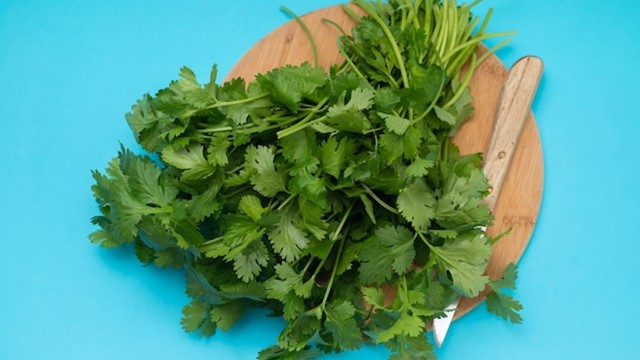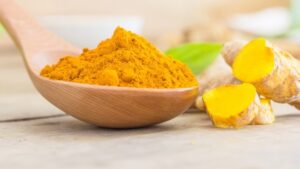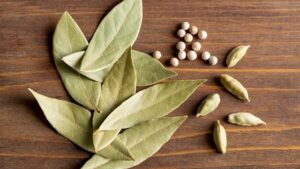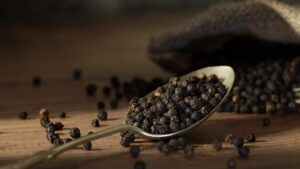Coriander refers to both an herb and a spice derived from the Coriandrum sativum plant, part of the parsley family. This plant is cultivated for its leaves, known as cilantro or coriander leaves, and its seeds, known as coriander seeds.
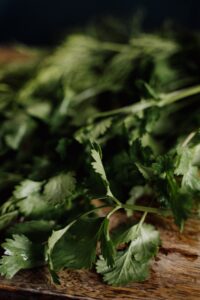
Characteristics of Coriander:
Here are the key characteristics of coriander:
Coriander Leaves (Cilantro):
- Appearance:
- Cilantro leaves are delicate, flat, and feather-like, resembling parsley leaves.
- They are bright green in color and grow on slender stems.
- Flavor Profile:
- The leaves have a fresh, citrusy, and slightly tangy flavor.
- Some describe the taste as a blend of parsley and citrus, with hints of earthiness.
- Culinary Use:
- Commonly used as a garnish, especially in Mexican, Indian, Middle Eastern, and Southeast Asian cuisines.
- Often incorporated into salads, salsas, guacamole, curries, soups, and as a topping for various dishes.
Coriander Seeds:
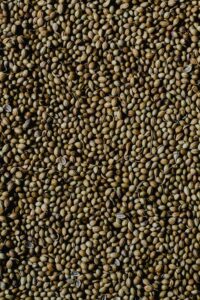
- Appearance:
- The seeds are round and slightly oval-shaped.
- They are yellowish-brown with distinctive longitudinal ridges on their surface.
- Flavor Profile:
- Coriander seeds have a warm, aromatic, and slightly citrusy flavor.
- They offer a mild, sweet taste with subtle hints of floral notes.
- Culinary Use:
- Widely used as a spice in both whole and ground forms.
- Found in numerous spice blends, pickling recipes, curry powders, meat rubs, and various savory dishes.
Versatility:
- Dual Usage: Both the leaves and seeds of the coriander plant are used in cooking, offering distinct flavors.
- Global Culinary Influence: Coriander is a staple in many cuisines worldwide, contributing unique flavors to a diverse range of dishes.
- Balancing Act: The leaves provide freshness and zing, while the seeds add depth and warmth to culinary creations.
Medicinal Potential:
- Historical Herbal Use: Traditional medicine has employed coriander for its supposed digestive and anti-inflammatory properties.
- Supplemental Usage: Coriander is sometimes used in herbal teas or as a supplement for its perceived health benefits, though further scientific research is needed to
Culinary Uses:
Coriander, known for its versatile taste, is used in various culinary applications worldwide. Here’s an overview of its culinary uses:
Coriander Leaves (Cilantro):
- Garnish and Flavor Enhancement:
- Fresh Garnish: Cilantro leaves are commonly used as a fresh garnish on numerous dishes, adding color and a vibrant, citrusy flavor.
- Topping Salads: Adds a refreshing and zesty element to salads, enhancing their taste and appearance.
- Key Ingredient in Ethnic Cuisines:
- Mexican Cuisine: Essential in dishes like salsa, guacamole, and tacos, lending a distinct flavor.
- Asian and Middle Eastern Cuisine: Used in curries, chutneys, soups, and stir-fries, providing a fresh, aromatic touch to these dishes.
- Herb for Sauces and Dressings:
- Sauces: Blended into sauces, such as chimichurri or green sauces, to provide a tangy and herby flavor.
- Dressings: Incorporated into dressings for salads or marinades for meats to infuse a citrusy note.
Coriander Seeds:
- Spice in Various Cuisines:
- Spice Blends: Often found in curry powders, garam masala, and spice mixes, contributing warmth and depth to these blends.
- Pickling and Preserving: Used in pickling recipes, imparting a distinctive flavor to preserved vegetables.
- Meat and Vegetable Dishes:
- Meat Rubs: Ground coriander seeds are used as a spice rub for meats, providing a subtle, fragrant flavor.
- Vegetable Dishes: Added to vegetable-based dishes like roasted veggies or sautéed greens to enhance their taste profile.
- Baking and Bread Making:
- Baked Goods: Coriander seeds are sometimes used in baking, particularly in bread, adding a subtle, aromatic touch.
Versatility:
- Flavor Enhancement: Coriander, in both leaf and seed forms, imparts a fresh, citrusy flavor to dishes while offering warmth and depth.
- Complementary Spice: Blends well with other spices like cumin, turmeric, chili, and ginger, enhancing their flavors when used together.
Conclusion:
Coriander, in its various forms, serves as an essential ingredient in a wide array of culinary delights. Whether as fresh cilantro leaves or aromatic seeds, it elevates the taste of dishes across different cuisines, providing a balance of freshness, tanginess, and warmth to culinary creations.
Medicinal Uses:
Coriander has been historically recognized for its potential medicinal properties and has been used in traditional medicine for various purposes. While more scientific research is ongoing, here are some of the perceived medicinal uses of coriander:
Digestive Health:
- Digestive Aid: Traditionally used to aid digestion, alleviate gas, and ease digestive discomfort due to its carminative properties.
- Stomach Upsets: Some herbal practices suggest using coriander to alleviate mild stomach upsets.
Anti-inflammatory and Antioxidant Potential:
- Anti-inflammatory Properties: Studies suggest that compounds in coriander, including antioxidants, may possess anti-inflammatory properties, potentially aiding in reducing inflammation in the body.
- Antioxidant Effects: Coriander contains antioxidants that combat oxidative stress, which could contribute to overall health.
Cholesterol and Heart Health:
- Cholesterol Management: Some research indicates that coriander might aid in maintaining healthy cholesterol levels. However, further studies are needed to validate these effects.
- Potential Cardiovascular Benefits: Coriander’s antioxidant properties could potentially support heart health, but more scientific evidence is required to confirm these effects.
Blood Sugar Regulation:
- Blood Sugar Management: There’s limited evidence suggesting that coriander might help regulate blood sugar levels, possibly benefiting individuals managing diabetes. However, more research is necessary in this area.
Skin Conditions:
- Skin Health: Some traditional practices recommend using coriander for certain skin conditions due to its purported antibacterial and anti-inflammatory properties.
- Wound Healing: It’s believed to aid in wound healing, although more scientific evidence is required to support these claims.
Historical Significance:
The historical significance of coriander dates back thousands of years and has played a significant role in various cultures:
Ancient Civilizations:
- Egyptian Use: Coriander seeds were discovered in Egyptian tombs dating back to 5,000 BC, showcasing its importance in ancient Egyptian cuisine and rituals.
- Mention in Ancient Texts: The seeds are mentioned in ancient Sanskrit texts, Greek writings, and the Bible, indicating its widespread usage in different cultures.
Medicinal and Culinary Importance:
- Ayurvedic Medicine: In Ayurveda, the traditional Indian system of medicine, coriander was valued for its purported digestive benefits and as a remedy for various ailments.
- Greek and Roman Influence: Both Greek and Roman cultures used coriander in cooking, preserving, and for its perceived medicinal properties.
Middle Ages to Renaissance:
- Medieval Europe: Coriander was popular in medieval European cuisine, used in various dishes, sauces, and as a preservative.
- Herbal Medicine: It was employed in medieval herbal medicine for its potential digestive and healing properties.
Global Migration and Culinary Influence:
- Spread to Asia and the Americas: With trade routes, coriander spread to Asia, where it became integral in cuisines like Indian, Middle Eastern, and Southeast Asian.
- Mexican Cuisine: Introduced to the Americas by the Spanish, coriander (cilantro) became a staple in Mexican cuisine, particularly in salsas, guacamole, and other dishes.
Cultural and Ritual Significance:
- Symbolism and Rituals: In some cultures, coriander held symbolic significance, associated with love, protection, and even used in religious rituals or ceremonies.
- Cultural Integration: It integrated into various cultural practices and cuisines, contributing to the rich diversity of global culinary heritage.
Health and Wellness:
Coriander, renowned for its culinary versatility, also holds potential health benefits. While research is ongoing and more evidence is needed, here are some perceived health and wellness aspects associated with coriander:
Digestive Health:
- Carminative Properties: Traditionally, coriander has been used to aid digestion and alleviate digestive discomfort due to its carminative properties.
- Gas and Bloating: It’s believed to help reduce gas and bloating, promoting digestive comfort.
Anti-inflammatory and Antioxidant Effects:
- Anti-inflammatory Properties: Compounds in coriander, including antioxidants, may possess anti-inflammatory properties, potentially reducing inflammation in the body.
- Antioxidant Benefits: Coriander contains antioxidants that combat oxidative stress, contributing to overall health.
Potential Cholesterol Management:
- Cholesterol Levels: Some studies suggest coriander might assist in maintaining healthy cholesterol levels, but more research is required to confirm and understand this effect.
Blood Sugar Regulation:
- Blood Sugar Balance: There’s limited evidence suggesting coriander may help regulate blood sugar levels, potentially supporting individuals managing diabetes. However, further research is necessary.
Skin Health and Wound Healing:
- Skin Conditions: In traditional practices, coriander has been used for certain skin conditions due to its purported antibacterial and anti-inflammatory properties.
- Wound Healing: It’s believed to aid in wound healing, although scientific evidence is needed to substantiate these claims.
Other Uses
Apart from its culinary and potential medicinal uses, coriander also finds applications in various other areas:
Aromatherapy and Perfumery:
- Essential Oil Production: Coriander seeds are used to extract essential oil rich in aromatic compounds.
- Aromatherapy: Coriander essential oil is utilized in aromatherapy for its pleasant fragrance, often promoting relaxation and stress relief.
- Perfumery: Its aromatic qualities make it a common ingredient in perfumes and fragrances.
Culinary Arts Beyond Cooking:
- Herbal Tea: Coriander seeds are occasionally used to brew herbal teas, providing a mild, fragrant flavor profile.
- Flavoring Liquors: Coriander is employed in some spirits and liqueurs for its distinctive taste and aroma.
Horticultural and Gardening Uses:
- Companion Planting: It’s believed that planting coriander near other plants can repel certain pests in gardening.
- Herbal Gardens: Grown for its ornamental value in herb gardens due to its delicate foliage.
Traditional Medicine and Folklore:
- Traditional Healing Practices: In some cultures, coriander has been used in traditional herbal medicine for various ailments, beyond its culinary applications.
- Folk Remedies: Folklore often attributes coriander with protective or medicinal qualities, used in various remedies and practices.
Industrial Applications:
- Food Industry: The essential oil derived from coriander seeds is used as a natural flavoring agent in food processing.
- Cosmetics: Its aromatic properties make it a common ingredient in skincare and cosmetic products.

